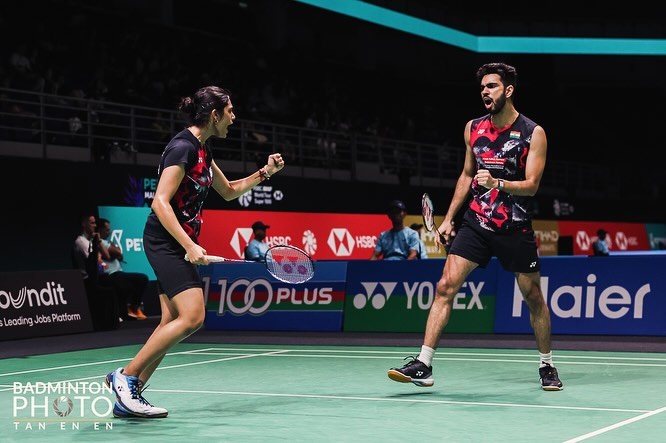
The promising rise of the mixed doubles pair Tanisha Crasto and Dhruv Kapila has been a major highlight for Indian badminton since the Paris 2024 Olympics. The duo reached a career-best world ranking of 17 in April and currently sit at number 18.
In a candid conversation with Revsportz, the pair opened up about the lack of job security faced by athletes, even after achieving success on the international stage. While appreciating the support extended by corporate initiatives, they stressed the need for stronger systemic backing to help build India’s badminton bench strength. The duo also shared their goal of breaking into the world’s top 10 within the next six months.
You’ve recently broken into the top 20 in the world — a huge milestone. What clicked between you two that made this partnership work so well?
Tanisha Crasto: Dhruv is an excellent backcourt player, he controls the game really well and has a strong understanding of mixed doubles strategy. Similarly, I believe he needed a partner who could dominate at the net, and that’s where I feel my strength lies.
Our combination works so well because we truly complement each other, and that balance is what makes this partnership special.
When you’re on court, there’s clearly a strong synergy. Do you have fixed roles, or is it all instinctive now during rallies?
Dhruv Kapila: We have fixed roles, but it’s not like we have to follow them strictly. We have a few things, and we’ve prepared those things very well — like, you have to do this and I have to do that. So we just follow that.
Tanisha: It’s more about adapting to the situation at that given time. Sometimes what we plan doesn’t go according to the way we want it to, so it’s more about adjusting to the circumstances at that moment.
How do you work on your chemistry off the court? Is it all training, or do you also bond as friends beyond the sport?
Tanisha: I think we do talk about our matches – where things went wrong, what were the good things about our matches. And I think that way we get good clarity on what are the things we can improve on and what are the things that were good, which we need to keep continuing. So I think that way we share a good bond, and it really helps us grow together.
Let’s talk about that Sudirman Cup comeback win over Indonesia — it was the only cherishable moment of the tournament for India. What was going through your mind after dropping the first game?
Dhruv: I think in that moment, I was just thinking, “We can’t play this plan, actually.” We were just struggling a lot. I didn’t know what we were doing — there were no plans, no clue. But still, in the second game, we started pushing. We said, “This is not our game. We have to take it out.” And then, yeah, we won the second set. In the third set, we were trailing, I think it was 19-16, but we had this belief, like, “Okay, we can do this.” And especially, I was believing in myself that I will take this out. Anyhow, I will just take this game this time.
Tanisha on the conversation between the two during the game: I think after we changed sides after the first game, we still had a lot of belief in ourselves. Dhruv and I told each other that we were really going to do it in this game. We didn’t let the first game affect us. We went all in, with full energy, better body language, and better choices of strokes in the second game, which I think really led to us winning the second and third games.
Indian badminton’s bench strength is under scrutiny. What do you think is the biggest reason for that weakness? And in your opinion, what can be done to turn that around and build a stronger second line?
Tanisha: I think India is really progressing now, especially over the past couple of years. The rise of players like Satwik, Chirag and others has played a significant role in inspiring and helping many athletes come up. As you can see, a lot of junior athletes are now performing very well on the international circuit. I believe that consistent support for these athletes will help us reach that global benchmark.
Countries like China, Japan, and Korea have a large pool of players and offer numerous opportunities, along with excellent facilities and strong training regimes, all of which contribute to their success. India is slowly moving in that direction. While it’s taking time, I believe we’re getting there, and very soon, you will see many young Indian athletes competing in top-level matches around the world.
“It is not advisable for children to take up sport,” said Pullela Gopichnad. In that context, How do you see corporations like Reliance Foundation, which supports you as well, contributing to this vision and helping create a more unified, high-performance training ecosystem?
Dhruv: I don’t think he meant it that way. He was trying to say that he, she and I have all been in the circuit for a long time, but we still haven’t gotten a job. That’s why we don’t have a job. So, he was trying to make the point that even if you reach a certain level, there’s still no guarantee of getting a job or a good job. That’s what he meant, and we agree with him.
There really should be some solution — if someone is achieving so much, there should obviously be a government job available. But unfortunately, there isn’t.
Tanisha: Like you said, the Reliance Foundation stepping in and helping athletes would really make things easier for those who may not have the financial means but have the will and determination to pursue badminton, or any sport for that matter.
I believe these foundations play a crucial role in helping athletes reach at least a foundational level, giving them a platform from which they can start thinking seriously about taking their sport to the next stage. Sometimes, all it takes is that one boost or support to push them forward. So, with more foundations like the Reliance Foundation coming into the picture, I think we will see a lot more athletes rising in the near future.
You’ve hit a career-high ranking of 17 as a pair. What are your short-term goals from here, and what’s the bigger vision?
Dhruv: For now, I think our main target for the next six months is to perform well. Like, the aim is just to try and reach the semi-finals, quarter-finals, qualify for major events like the 1000 series, and then work on getting our ranking into the top 10.
Also Read: HS Prannoy Reflects on Struggles, Recovery & Why Indian Badminton Needs to Reunite to Move Forward
For Latest Sports News Follow: Revsportz



